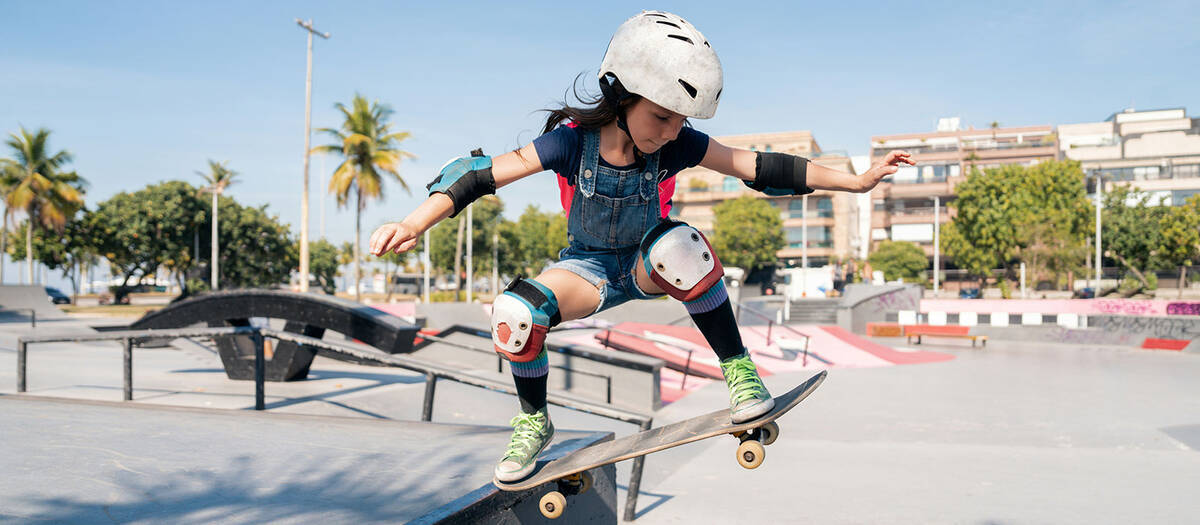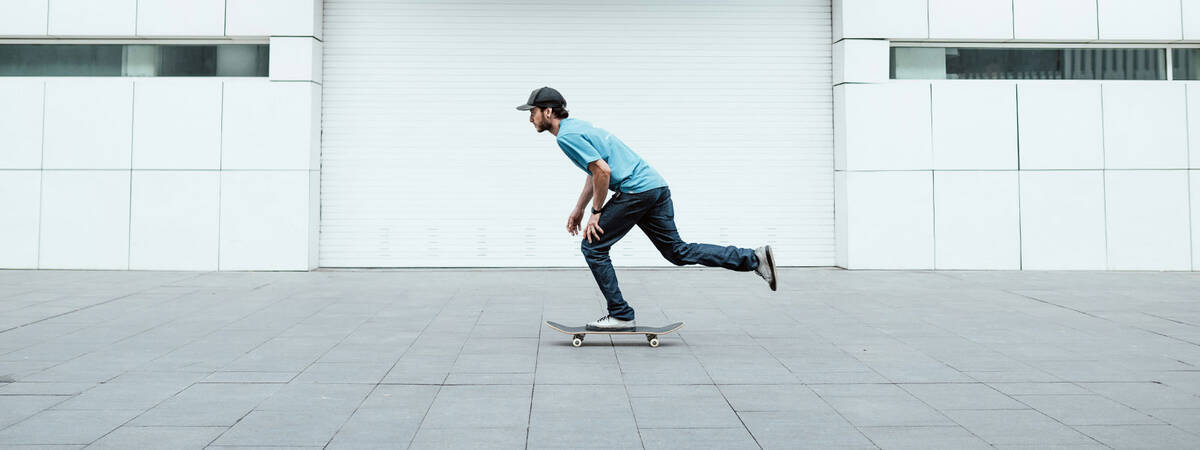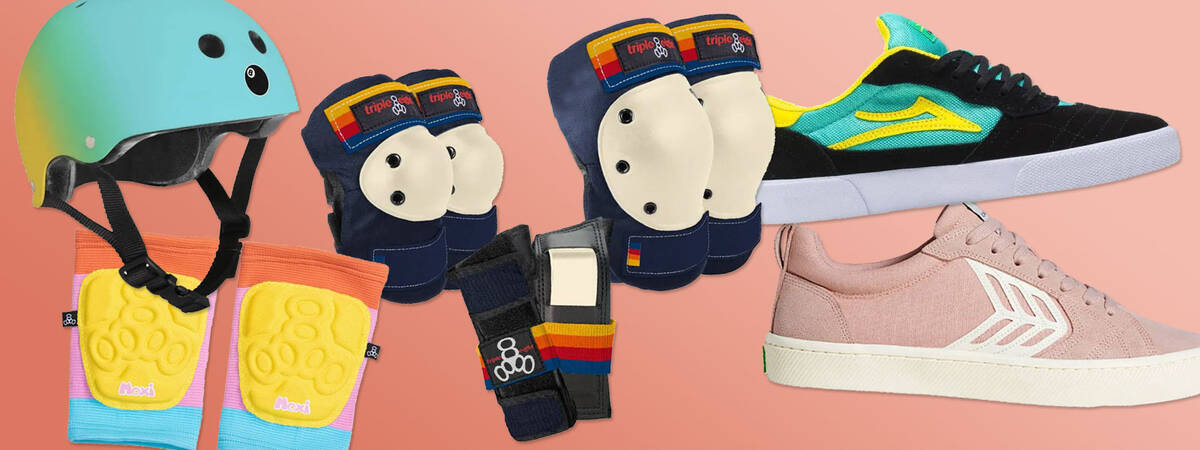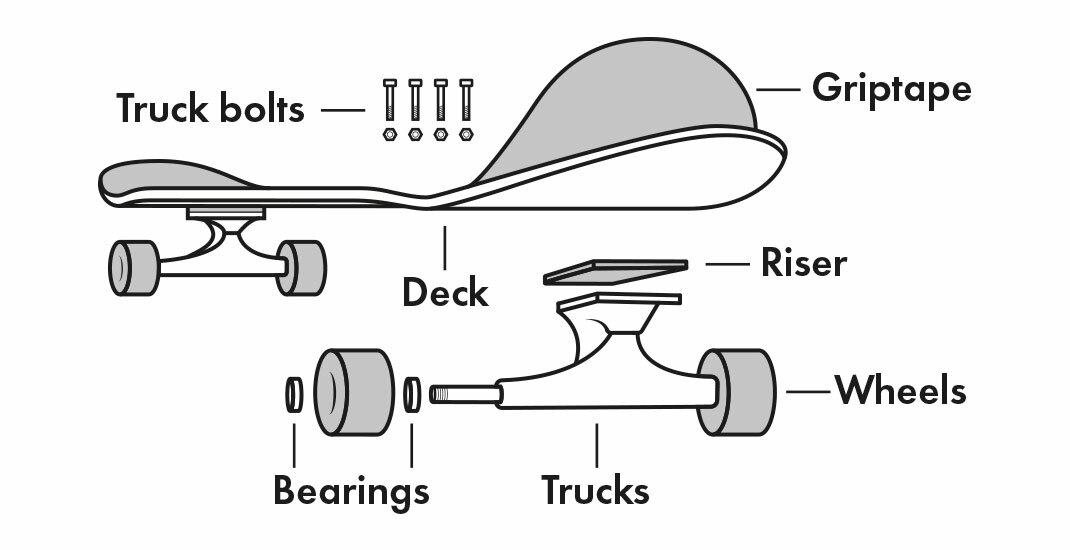Buying Skateboards – A Beginner’s Guide
Welcome to our skateboard buying guide for beginners. With this guide, you'll be equipped to choose the best skateboard for beginners. Acquiring the right starter skateboard is vital for those who embrace skateboarding for the first time. This holds true for beginners of all ages, because a good beginner skateboard will help your development and most likely, it will last longer.
It's worthwhile to carefully evaluate the various options when selecting a beginner skateboard. There are far more differences between skateboards than one might anticipate, and with this guide, we aim to shed light on the most important questions you may have, whether you're a beginner or returning to skateboarding after a lengthy hiatus.
Overview
Skateboard Types for Beginners

When choosing your first skateboard, it's crucial to consider the style of skateboarding you anticipate enjoying the most. As you progress, you'll develop a clearer understanding of your skateboarding preferences, enabling you to make more specific choices. As a novice, opting for a versatile skateboard that allows you to learn basic tricks and maneuvers is advisable. There's no need to make highly specialized decisions at this stage.
As a beginner, you need to decide between these three main types of skateboards:
- Skateboards: Trick-oriented skateboards, commonly used for street and park skating, feature concave-shaped decks with double kick tails and small wheels. These provide beginners with a stable platform to embark on their skateboarding journey.
- Cruiser Skateboards: If your primary interest in skateboarding lies in transportation or cruising, a cruiser skateboard is the ideal choice. With wider decks and softer wheels, cruisers offer enhanced comfort and maneuverability, ensuring a smooth ride on uneven surfaces. If cruisers are what you are after, read our Guide to Buying Cruiser Skateboards or head directly to our selection of high-quality Cruiser Skateboards.
- Longboards: For beginners seeking stability and a smooth ride, longboards are an excellent option. Particularly well-suited for commuting and downhill riding, longboards provide a relaxed and stable introduction to skateboarding. With disciplines like longboard dancing, freestyle, or downhill longboarding has a lot to offer. If you want to pursue longboarding, check out our Guide to Buying Longboards, or go ahead and browse our selection of Longboards.
In this guide, the primary focus is on regular skateboards that are perfect for beginner skateboard tricks.
What Are the Best Beginner Skateboards for Kids & Teenagers

Complete skateboards are an excellent choice, especially for young novice skaters. So, what should you look for in a complete skateboard for beginners? You'll want a skateboard that facilitates learning to push, balance, and steer the board in the right direction. These foundational skills in skateboarding offer numerous hours of excitement and thrill, laying the groundwork for future adventures in skateboarding.
People often ask for beginner skateboards for girls or a cool skateboard for boys, and don’t worry – you are spoiled with choices to match the specific aesthetic preferences of the person who will be using the board.
An inexpensive skateboard will suffice during the initial stages of the learning curve, but consider whether the skateboard you choose should support further growth as a skater.
At some point, any skater will progress to popping ollies and doing tricks, and having a hard and snappy deck becomes advantageous to get the most out of the effort. When getting a skateboard for someone at this stage, it's advisable to consider a complete skateboard that falls slightly higher in the price range, although it's not mandatory.
The following specifications deserve your attention when choosing a complete children's skateboard:
- Deck width: Opt for a skateboard width roughly equivalent to the length of the child’s shoes. A skateboard that's too wide can be challenging to steer, while one that's too narrow may compromise stability. For further details, consult our Skateboard Size Guide or read more on the subject further below in this guide.
- Wheel hardness: A wheel hardness of no more than 92A is advised for beginners. Softer wheels are less prone to sudden stops when rolling over small pebbles or cracks in the ground, reducing the amount of falls that may spoil the fun for someone who is just getting into skateboarding.
- Bushings: For children weighing less than 65 kg, it's recommended to select a skateboard with bushings below 90A hardness. The hardness of the truck bushings determines the amount of pressure required for the skater to steer the skateboard in a specific direction. Opting for softer bushings (with a lower durometer rating) makes steering easier, while harder bushings (with a higher durometer rating) can make steering more challenging.
When browsing our selection of Complete Skateboards, you can filter the boards by wheel hardness and deck length, so that you only see the skateboards that match your needs.
What Are the Best Beginner Skateboards for Adults

With the right complete beginner skateboard, adults can confidently embark on their skateboarding adventures, regardless of their age or prior experience. Whether you're a complete novice or getting back into skating after some time away, you will be able to find a pre-built complete skateboard that satisfies your needs, but it is a good idea to choose wisely – especially because as an adult, you probably weigh more than a teenager does.
To choose the right complete skateboard for an adult beginner, consider the following specifications:
- Wood type: Opt for a 7-ply maple deck. It's recommended to avoid Chinese maple due to its tendency to be softer and less durable, largely because of the faster growth rate of maple trees in China. Maple sourced from colder climates, where trees grow more slowly, tends to be harder and firmer, resulting in skateboard decks that have more pop and are more durable.
- Adult skateboard size: To choose the right size skateboard as an adult beginner, it's recommended to approximate the width of the deck to the length of your shoes. Opting for a deck wide enough for your feet will make steering easier. As a beginner, it's advisable to adhere to our general recommendations (provided below). As you progress to the intermediate level, you may develop preferences that differ from these general recommendations.
- Wheel hardness: Choose a wheel hardness below 97A. Harder wheels absorb fewer vibrations from rough surfaces. Conversely, softer wheels offer less responsiveness and playfulness. While technically advanced skaters often prefer ratings above 97A, beginners are typically better off with softer wheels.
- Bushings: The hardness of the truck bushings affects the steering capabilities of the skateboard. Generally, the heavier you are, the harder you want your bushings to be. For individuals weighing between 65 - 79 kg, opt for 85A to 95A bushings, while those weighing 80 kg or above should choose 91A bushings or above.
Getting Back Into Skateboarding as an Adult
Never too old to skateboard! Even if you've been away from it for a while, you're not starting from scratch, and your experience still holds value. After all, skateboarding essentials remain unchanged - a wooden deck, two trucks, and four wheels.
How to get back into skateboarding? Choose a skateboard that suits your needs and let muscle memory kick in. Whether you're aiming to dominate the skatepark or hit up local street spots, choose a skateboard that aligns with your goals.
Skateboards for old guys are often better suited for cruising, because many find it pointless to aim for hardcore shredding. If you're an adult getting back into skateboarding, opt for a wider deck with slightly softer wheels. For occasional technical tricks, ensure your deck features kick tails at both ends.
Experienced skaters getting back into skateboarding already know a thing or two about skateboards and parts, so building your own custom skateboard tailored to your needs is the ultimate option. Explore our Custom Skateboard Builder or browse our extensive catalog of Skateboard Parts to handpick each component for your unique setup.
Choosing the Best Skateboard Size for Beginners
If you follow our skateboard size chart, you'll be able to find a suitable size for your first skateboard. When it comes to skateboard sizes, the main concern is the deck width. Typically, your desired deck width will change over time. As you develop interest in specific styles of skateboarding, you'll choose a deck width that suits your new riding style better. However, as a beginner, we recommend selecting skateboard size based on your shoe size.
If you are getting a first-time skateboard for a kid, following the size table is also your best bet.
| Skateboard Width | Recommended Age | Shoe size US | Shoe size UK | Shoe size EU |
| 6.5" | 3 - 5 | 6C - 11C | 5Y - 10Y | 23 - 28 |
| 6.75" | 3 - 5 | 7C - 11C | 6Y - 10Y | 24 - 28 |
| 6.825" | 4 - 6 | 9C - 12C | 8Y - 11Y | 26 - 30 |
| 7.0" | 5 - 7 | 10C - 1 | 9Y - 12Y | 28 - 32 |
| 7.125" | 6 - 8 | 11C - 2 | 10Y - 1 | 29 - 33 |
| 7.25" | 7 - 9 | 12C - 3 | 11Y - 2 | 30 - 34 |
| 7.375" | 8 - 10 | 13C - 4 | 12Y - 3 | 31 - 35 |
| 7.5" | 9 - 11 | 1 - 6 | 13Y - 5 | 32 - 38 |
| 7.625" | 10 - 12 | 2 - 7 | 1 - 6 | 33 - 39 |
| 7.75" | 12 - 14 | 4 - 9 | 3 - 8 | 35 - 42 |
| 7.875" | 12 - 14 | 4 - 9 | 3 - 8 | 35 - 42 |
| 8" & Up | 14 & Up | 9 & Up | 8 & Up | 42 & Up |
Skateboard Tips for Beginners

Learning the basics of skateboarding can take time and require practice, but the best advice is simple: don't give up! Have as much fun as possible, follow your instincts, and soon enough, you'll be flying around the skatepark. Here's some practical advice that may be useful:
Skateboard Protective Gear for Beginners
For both beginners and pros, we recommend to skateboard with helmets and pads. Fear of falling can hinder your progress, but high-quality skateboard wrist, knee, and elbow pads, along with a certified skate helmet, can relieve your fear of falling and improve performance. Stay safe and skate confidently with protective gear. Any beginner should keep this in mind!
Browse our selection of Skateboard Pad Sets and certified Skateboard Helmets.
We also have the best kids' helmets and skateboard pads in our selection of Skateboard Protection for Kids.
Skate Shoes
Designated skate shoes from well-known skate shoe brands are a worthwhile investment. While you can skate in any sneaker, sooner or later, you'll want to consider real skate shoes.
So what are the advantages of getting real skate shoes?
Firstly, they improve your skating: with flat soles and enhanced grip, they provide excellent traction on the deck. The soles are designed to optimize "board feel," enhancing your feeling of control over the board. This results in more responsiveness and increased control over the skateboard.
Secondly, skate shoes are designed to endure the wear and tear of skateboarding. Skateboarding is definitely hard on your footwear. High quality skate shoes last longer and will continue to last through many more sessions than a regular pair of sneaks.
Browse our selection of Skate Shoes.
Skateboarding Pants
When skating, you need pants that are flexible and durable. As a beginner, you will fall quite often, and your pants will suffer the consequences. Additionally, your pants must not compromise your range of movements. A stretchy material and/or a loose fit is recommended for skate pants.
If your pants do not compromise your movements and are made from durable fabric, they will be good for skating. In fact, many of the most popular skate pants are workpants. Browse our selection of pants to find your new designated Skate Pants, and we also have a fine selection of Skater Belts!
Truck Tightness
The maneuverability of your skateboard can be adjusted by either tightening or loosening the trucks. Your skateboard should respond to the direction in which you lean when rolling. If it doesn't, consider loosening the trucks slightly. Conversely, if you find it difficult to maintain control because the skateboard moves too much, tighten the trucks. Adjusting the kingpin nut can change the riding characteristics of your skateboard significantly!
Since every skater has a different weight and height, the amount of pressure from leaning on the trucks varies. As a result, there's no standard truck tightness, so experimenting to find the sweet spot that enables stable and consistent rolling is a good idea.
Watch this video to learn how to adjust your skateboard trucks, and remember that a Skate Tool is a low-cost, long-term investment.
Skateboard Parts – The Anatomy of a Skateboard

Assembling your own custom skateboard is the best option if you're serious about skateboarding. Even if you're purchasing a beginner complete, it's valuable to understand the essentials about skateboard parts - aka. the anatomy of a skateboard.
There are compelling reasons to opt for a custom skateboard as a beginner. Whether you've fallen in love with the graphics on a deck sold separately or want to get the best quality trucks, assembling your own skateboard allows you to choose the exact parts you need.
If you find it intimidating to apply grip tape or mount wheels, consider our Custom Skateboard Builder. Our team of passionate experts can assemble the entire skateboard for you, ensuring it's ready to ride right out of the box.
Let’s make a quick rundown of the different parts of a skateboard:
Skateboard Decks
Skateboard decks are typically constructed from layers of wood known as ply. Most decks for trick skateboards are made of 7-ply maple. The best boards for beginner skateboards are made from harder types of maple to ensure durability. The deck is one of the main components of a skateboard, serving as the platform for all tricks and maneuvers.
Read our detailed Guide to Buying Skateboard Decks, or check out our full selection of Skateboard Decks.
Skateboard Trucks
Skateboard trucks are located underneath the skateboard deck and consist of metal T-shaped components to which the wheels are mounted. Serving as the steering mechanisms of the complete skateboard, trucks play a crucial role in determining its maneuverability and riding characteristics.
For more information on skateboard trucks, including details about bushings, hangers, and baseplates, check out our extensive Skateboard Truck Buying Guide. If you already know what you are after, you can browse our full selection of Skateboard Trucks.
Skateboard Wheels
Skateboard wheels are made of polyurethane and come in various sizes, hardness levels, and shapes. They play a crucial role in determining the smoothness, speed, and grip of the skateboard.
As a beginner, it's important to pay attention to the hardness of the wheels you choose, and skateboard wheel hardness is always rated on the durometer scale. These are our general skateboard wheel recommendations for beginners:
- Kids should opt for wheels with a durometer rating of 92A or less.
- Adult beginners should choose wheels with a durometer rating of 97A or less.
Diameter-wise beginners who want to learn tricks are advised to stay within the 52 - 54 mm range
For more in-depth information on skateboard wheels, check out our comprehensive Guide to Buying Skateboard Wheels. You can also go ahead and browse our complete selection of Skateboard Wheels. To make things easier, you can filter the wheels by hardness or other relevant specifications to find the models that suit you best.
Skateboard Bearings
Skateboard bearings are housed inside the wheel's cores and are responsible for facilitating smooth and efficient wheel rotation, allowing your skateboard to roll with minimal friction. Bearings come in various ABEC ratings, ranging from ABEC 1 to ABEC 9, with higher numbers indicating smoother operation. However, in skateboarding, factors such as material quality, lubrication, and maintenance have more impact on bearing performance than the ABEC rating alone. Therefore, as a beginner, you don't need to focus much on the ABEC rating.
If you notice that your wheels are not spinning as efficiently as they used to, check out our guide on How to Clean and Maintain Bearings.
Discover our complete selection of Skateboard Bearings, or dive deep into the technicalities in our comprehensive Bearing Guide.
Skateboard Griptape
Skateboard griptape is the rough, sandpaper-like material found on the top surface of the skateboard deck. It helps you control the board and prevents your feet from slipping. When you slide your feet along the top of the deck, the griptape provides friction. Along with a snappy pop of the kicktail to the ground, a sliding motion along the length of the griptape enables you to lift the board higher off the ground in ollies.
Skateboard griptapes come in many different colors, with graphics or clear versions. Browse our selection of Skateboard Griptape and discover the variety!
If you need to apply griptape, here’s a short video tutorial on applying griptape:
